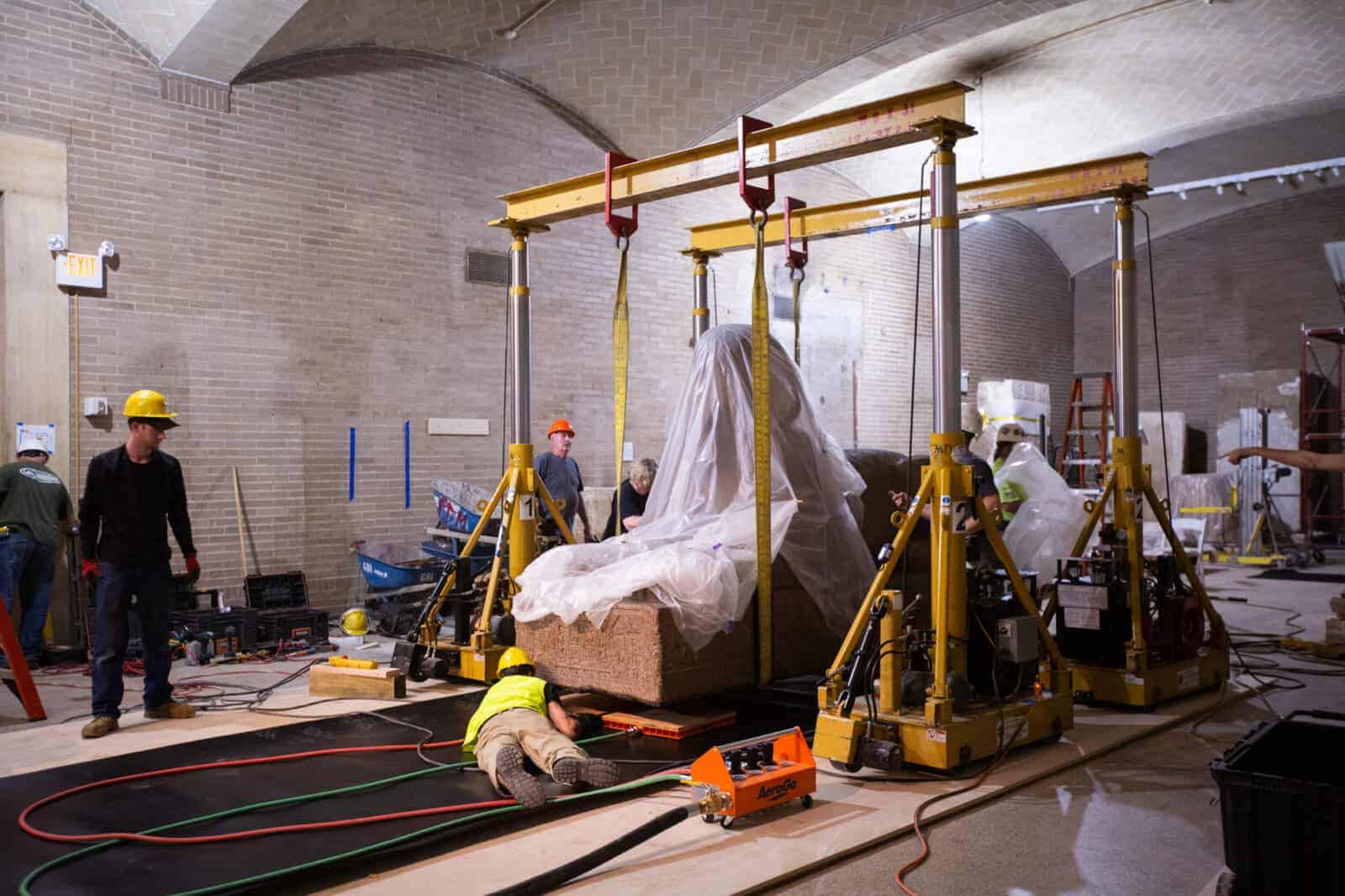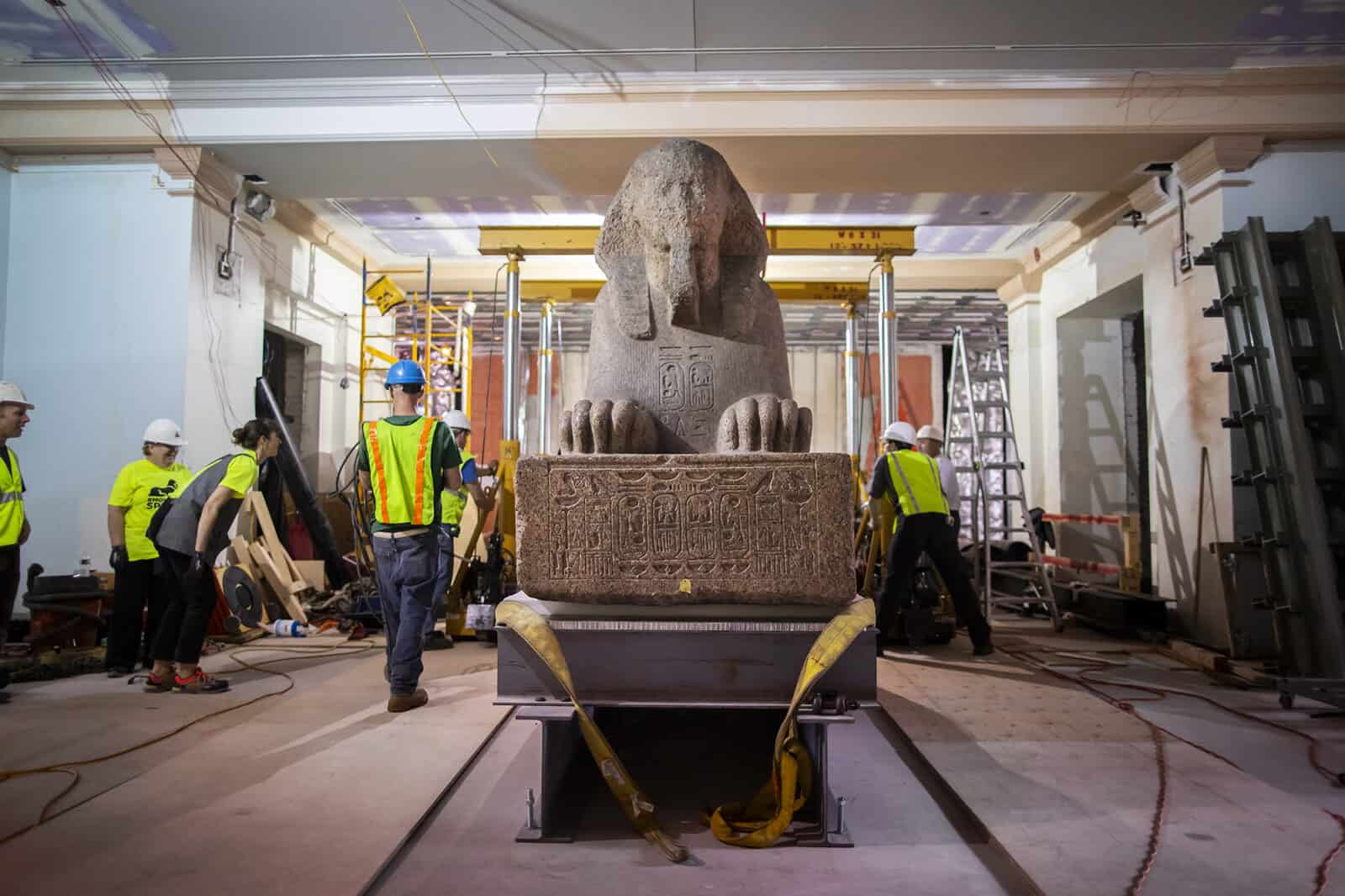
Guaranteed to make Ancient Technology buffs smile! Story says the ancient Egyptians used wooden rollers and sleds. Maybe with a “small” sphinx. But it wouldn’t explain how the Giza Pyramids were built! I’m guessing this story will have the spirit of Imhotep will chuckling from his abode in the Duat!
Old met new last week when engineers used high-tech levitation devices to move an ancient Egyptian Sphinx weighing 12.5 tons 300 feet to the entrance hall of the University of Pennsylvania Museum of Archaeology and Anthropology.
The 3,000-year-old monument had been first excavated by archaeologists in 1913 from the Temple of the God Ptah in Memphis, Egypt before being shipped to the United States by boat. It then rested in the outdoor courtyard of the museum for three years until it was moved inside and has been the crown jewel of the museum’s Egyptian gallery since 1926.
Until now.
As part of the transformation of the museum, the Sphinx needed to be moved to the entrance hall so it would be the first thing visitors see upon entering the facility, which is located in Philadelphia.
First, the museum had to figure out how to move the massive monument, much like how Egyptians had to figure it out 3,000 years ago.
At that time, the ancient Egyptians likely pulled and pushed the Sphinx, or the stone it was carved from, via sled into the temple where it rested for thousands of years. It’s just like how they moved the stones used to build the pyramids.
Luckily, we have modern technology to move heavy loads for us today. Only the transportation engineers had the task of figuring out how to move it without doing any damage to it. A single mistake could result in unwanted chips or worse.
The team placed a heavy-duty strap around the Sphinx and lifted it temporarily off its base using hydraulic machinery. It was then lowered to a few inches off the ground where “air dollies” rested on a wooden runway.
And that’s where the story takes a “Back to the Future II” twist. The “air dollies” literally made the Sphinx hover as four men continually pushed it forward, navigating the necessary route and technical difficulties along the way such as an incline and corners. Just getting out of the first doorway was a challenge because the room where the sphinx has rested since 1926 was built around it.
“The doorway was one of the worrisome spots,” associate curator and sphinx expert Jennifer Wegner told Penn Today. “Now the ramp is another when the incline starts. It’s still on the track, so that’s a good sign.”

Once again, the hydraulic lift was used to elevate the sphinx into position before being lowered onto its air pillow for another short distance.
“The most physically challenging part was that first big incline, which is what we expected,” special projects manager Robert Thurlow said. “The transition from flat to incline was a bit more difficult because of the seam, and the grade of the slope was tricky.”
Spectators cheered as the monument finally entered the entrance hall, where the hydraulic lift settled it on a temporary platform until it is lifted and lowered one more time on a permanent platform.
“It went as smoothly as we hoped,” Thurlow said. “We ran into a few problems we foresaw, and we used the backup plans to our backup plans. This was one of the most difficult things that any of us will ever work on. The fact that it is up here and safe, we can all feel really good about it. The Sphinx is in as good of shape as when we started.”

The Sphinx will now greet those visitors as they enter the museum and serve as a popular display piece that brings joy to all those who admire it.
“The Sphinx will almost be Penn’s public face to the city,” Penn Museum William’s Director Julian Siggers said. “It is going to be one of the things Penn will be most proud of because there is no other university museum like this anywhere in the country. The Sphinx will be the first object you see as you enter.
“It is our most iconic object, but it is also standing in as a representation for the complete transformation of the Museum. Yes, it is going to be a big deal. It’s a huge moment for us. The Sphinx is much-loved in Philadelphia.”
Overall, the Sphinx only traveled a mere 300 feet but the journey cost $850,000 to achieve while the original 6,000-mile move in 1913 cost $794.
It’s value, however, is priceless because it’s a piece of history from a location that is so far away from most to see for themselves. The Penn Museum offers Americans the chance to see a piece of history firsthand, seeing as how the Sphinx is a representation of Pharaoh Ramses II.
Like a puck on an air hockey table, this ancient Egyptian monument floated through the air via technology the workers who originally hauled this stone into the temple 3,000 years ago would have marveled at. They certainly would have used it since it would have reduced the time they spent hauling.
It just makes us appreciate the ancient Egyptians and their achievements even more.
The sphinx can be publicly viewed again when the entrance hall reopens on November 16th.
Featured Image: YouTube screenshot
Here’s the vid:








